
想让你追我。
The Nutty Brothers | Yoko Lennon in 'Peace in Bed' in 1969; Soil Improvement Band Forced to Perform in Bed in 2021
Reminder: This article is likely to be harmonized, please pay attention to saving.
"Heavy Metal Country Tour 2021" will go to 8 heavy metal-contaminated villages in China to perform performances. Through heavy metal music, he will pay attention to heavy metal pollution, and try to promote the governance and change of relevant enterprises and departments.
On the afternoon of September 6th, we planned to perform at the poisonous copper mud pollution site in Yangchun, Guangdong in the afternoon, but before we set off, we found that a police uncle was waiting for us downstairs of the hotel. Jing car, epidemic prevention car, and 120 ambulance are all here (there are many choices, there is always one suitable for us). It turned out that the news that we were going to perform was exposed! Two days ago, our little friends entered the village to communicate and interview with many villagers, and invited them to perform with the band. Before that, we are very happy to finally have a stop where villagers who are deeply hurt by pollution can participate together. But in the preparation process, the news still leaked.
The situation has become a little more complicated. During the communication with the relevant departments, we were told that if we go to perform in the place where Yangchun is polluted, we will be forced to quarantine for 14 days in the name of epidemic prevention, even in an unoccupied place.
Later, the street secretary came, and the propaganda minister also came, and came to the standard room of the hotel where we stayed. The street secretary is said to have just assumed office for more than ten days. He spoke politely and wanted to receive us on official business (we refused), and expressed that the deputy mayor wanted to meet us to talk about environmental protection (we said there was no need to trouble the mayor). As for the Minister of Propaganda, as soon as he came up, he asked us if we had a performance license. He was very imposing...
Under such circumstances, it is impossible to decontaminate live performances, and it is also impossible to find villagers to perform.
After communication to no avail, we can only perform in the room where we are currently trapped, and we can only perform on the bed. So, in a room of more than ten square meters, it was crowded with more than a dozen people. Under the witness of villagers, reporters and officials (four or five cameras and several mobile phone lenses filmed the whole process), the heavy metal performance on the bed began! This may be the only heavy metal gig in music history to be forced into bed.
Outside the room, there are the propaganda minister and the street secretary who do not want to be photographed by the camera. Downstairs are the Jing car, the epidemic prevention car, and the 120 ambulance. At the intersection of power and suffering, a heavy metal music performance with a real rock spirit begins. !
... We never thought that in this cramped room, we would be infected by this performance, resonating with resonance, weeping, and at this moment, our nerves were exposed to the mournful singing, and the fate of the villagers was connected with the blood lin lin , where the relevant powers meet...
I am reminded of Lennon and Yoko Ono's "Peace in Bed" in 1969: Make love, don't fight! This famous anti-war performance art lasted for a whole week, and the two were in bed all the time. During these 7 days, this large bed and half-naked Lennon and Yoko Ono became the focus of the world's attention.
Perhaps, many years later, many people will remember that in 2021, the Soil Improvement Band will perform an unprecedented heavy metal performance on the bed, in order to control heavy metal pollution and for our common destiny: peaceful coexistence between humans and the environment.
After the performance in bed, we could only leave Yangchun at 7:00 p.m., and a minibus took us to Yangjiang High-speed Railway Station, which is 60 kilometers away. The street secretary was "accompanied" throughout the whole process, watching us enter the high-speed rail station, watching us really leave Yangchun, and then go back with confidence...
……………………………………………………………………
Tears bricks, green rice, fluorescent fish, cow poisoning, stroke, the village here is very strange
Investigation on the pollution incident of poisonous copper mud in Yangchun, Guangdong
Things are a little weird.
The red bricks used to build the house, after being knocked open, found luminous particles, which emit a strange little blue light in the night; the newly harvested rice, after being sealed for more than 20 days, began to turn green, and it smelled strange rust; Even the fish raised in the fish pond had colored fluorescence after the abdomen was cut open.
At first glance, it sounds like a fantasy world in a fairy tale. But something even scarier is happening—
The land here began to fail to grow crops, and the peanuts that finally grew, the seeds became very small; many of the paddies were empty shells; and the vegetables did not grow much. The buffalo here died in pieces, and the carcass was cut open, and the intestines were ripped inside. More and more people here are sick for no reason, strokes, cerebral hemorrhages, and almost the whole village are infected with strep throat.
Due to the highly toxic nature of the large quantities of copper mud shipped, many villages in Yangchun, Guangdong, are gradually turning into "hell on earth".
In January 2020, local villagers paid their own money to test the PH content of copper and nickel in the copper mud of Shahe Village, Yangchun, and found that the nickel content exceeded the concentration limit by five times. There is no doubt that these copper slimes are toxic and hazardous wastes. Around July 2020, Yangchun Environmental Protection Bureau commissioned technicians from the South China Environmental Testing Center to sample and test with a spectrum analyzer on site. It was found that the heavy metals such as chromium, nickel, lead, arsenic and copper in the sampled copper mud samples were seriously exceeded, up to ten times.
Where do these poisonous copper slimes come from? What's the harm? Who is responsible for this? How has the life of the local villagers been affected? Is the pollution still going on? With these questions in mind, in the spring of 2021, the author came to Yangchun, Guangdong to conduct a field investigation.
One factory illegally transferred and dumped more than 20,000 tons of poisonous copper sludge
Tens of thousands of poisonous copper mud was dumped and buried here.
The author visited 15 landfill sites of poisonous copper mud in the western part of Yangchun City, and found that the pollution caused by poisonous copper mud is far more serious than expected. The People's Procuratorate of Yangchun City, Guangdong Province had filed a lawsuit, but in the court's judgment, only three sites of poisonous copper mud buried in Shachang, Hegang Brick Factory, and Shahe Village's collective fish pond were recognized. The author visited and investigated and learned that there are countless neglected "footprints" of poisonous copper mud.
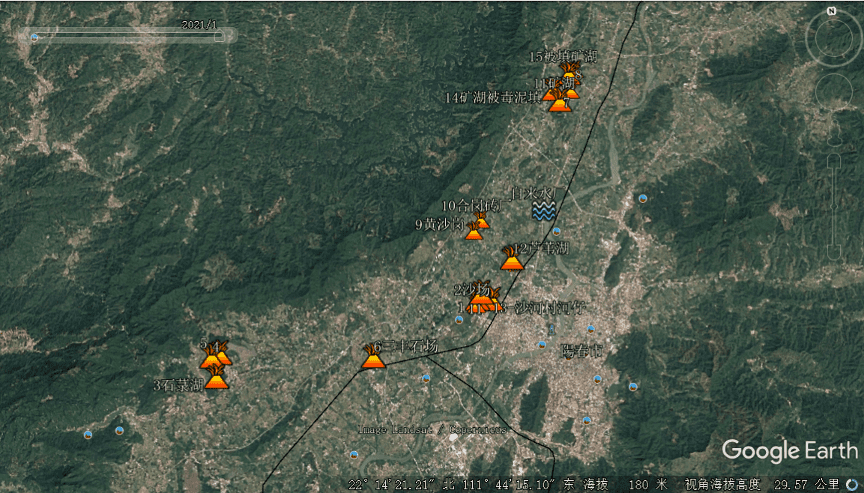
It all starts with a factory.
From the beginning of 2012 to September 2014, businessman Tang Yongding opened the Hongxiang Waste Slag Processing Plant in Jiangangling Industrial Development Zone, Hexi Sub-district Office, Yangchun City. In order to obtain large profits, the processing plant illegally purchased copper-containing waste from other places—copper slime to extract copper. During the copper smelting process, the generated waste residues are piled up in the open air, and no rain or leakage prevention measures have been taken. In addition to illegal storage, the factory owner also instructed the locals to dump the waste residue in abandoned cement factories and brick factories, and secretly landfill them in various pits and fish ponds in the village. In two years, the factory involved illegal transfer and dumping of more than 20,000 tons of poisonous copper sludge. The villagers took up the law and filed a lawsuit against the Hongxiang Waste Slag Processing Plant.
In 2018, the Fifth Central Environmental Protection Inspectorate happened to investigate in Yangchun, and the illegal dumping of poisonous copper mud was exposed. In addition, Yangjiang City, which manages Yangchun City, was also found to be lacking in environmental supervision of solid and hazardous waste, and a large amount of solid waste and hazardous waste was stored in the open for a long time, and the environmental risks were very prominent. In 2019, the People's Court of Yangchun City, Guangdong Province ruled that Tang Yongding and Yang Xiuhe, the owners of Hongxiang Metal Processing Factory, were guilty of environmental pollution and were sentenced to corresponding penalties.
However, the legal punishment and the central inspection did not bring an end to the poisonous copper mud pollution incident. For many, the hurt and grief caused by the poisonous copper slime continues.

The red brick used to build the house emits a strange blue light
Everything happens without the villagers' knowledge. When the environment first appeared abnormal, the villagers did not know what caused it.
Hong Xueying, a villager from Hegang Village in Yangchun City, used to be very hardworking and healthy. She never thought that the new house she built would cause her to suffer from severe stroke and hemiplegia.
In 2015, Hong Xueying bought a new house with red bricks from Hegang Brick Factory. The new house was built, but not yet renovated, and the family smelled a strange smell as soon as they moved in. Soon after, the family experienced dizziness from time to time. Hong Xueying was puzzled. She saw that a layer of light green had appeared on the surface of the remaining red bricks of the house. Knock on the red brick and find that there is a layer of emerald "sandwich" inside, which has iron red dots and obvious luminous particles.
Another villager also bought a brick house from Hegang Brick Factory. He knocked on the brick and saw the same glowing particles. In the dark night, these particles emit a faint blue light, which is very strange. The villagers speculated that the bricks may have been mixed with toxic copper mud, which contained a large amount of heavy metals, causing the bricks to shine.

The insider told the author that it turned out that in order to obtain huge income, the owner of Hegang Brick Factory illegally received poisonous copper mud from the Pearl River Delta and other places at a price of 850 yuan per ton, and pulled it into Hegang Brick Factory to mix it with mud to make bricks. Bricks mixed with poisonous mud are basically used for local construction, and many villagers use these bricks to build houses. From 2012 to 2017, Hegang Brick Factory pulled in poisonous copper mud for five consecutive years. In 2017, the villagers gradually noticed that the newly built houses were abnormal, and there were various physical problems, and they reported them one after another. Under the pressure of the villagers, the Hegang Brick Factory no longer uses poisonous copper mud to make bricks on the surface, but in fact, it will not officially stop making bricks until 2020.
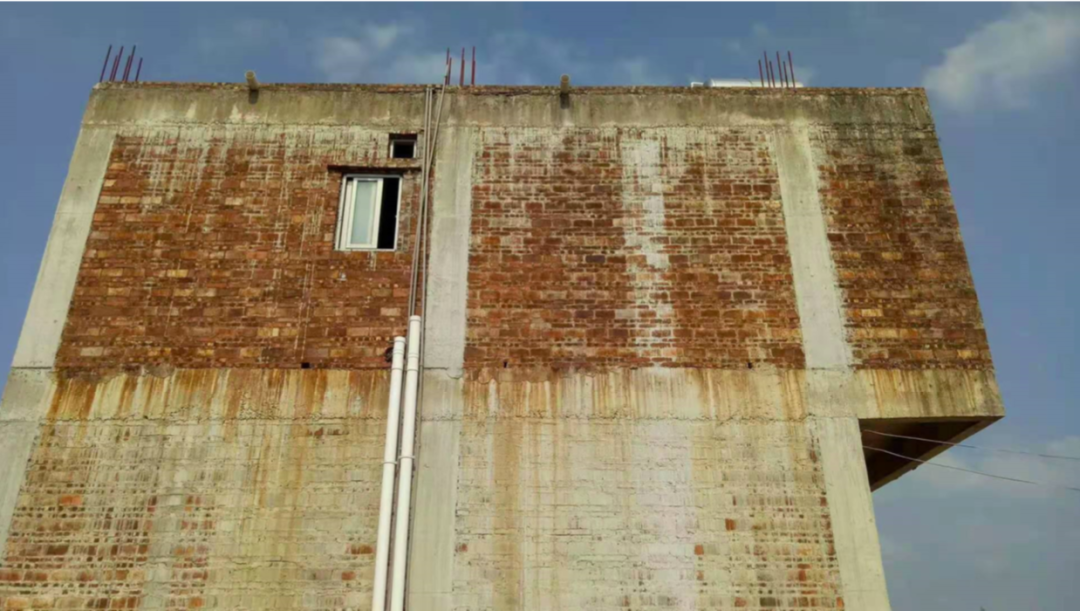

Yang Hongxu, a native of Shahe Village, revealed to the author that in Yangchun, in addition to Hegang Brick Factory, there are many brick factories that use copper mud to make bricks. One of the shareholders of Hegang Brick Factory has personally revealed that pulling copper mud into Yangchun has obtained the consent of the local government and the leaders of the Environmental Protection Bureau, and even each brick factory has been assigned certain tasks to deal with these hazardous waste copper mud in order to obtain Huge benefits in dealing with hazardous waste.
However, in reality, these brick factories are not qualified for hazardous waste treatment. They just mix part of the copper mud into the bricks, and the rest are piled up in the brickyard. The copper mud that the brick factory could not put down was piled up in other areas of the village at will—the transit area represented by Huangshagang had a large amount of poisonous copper mud piled up in the open air.
The villagers near Huangshagang were the first to notice the difference. The copper mud was piled up there in the open air, and the stench drifted everywhere in the wind. Then, the insider of the brick factory revealed that "copper mud is poisonous", and the Hegang Brick Factory and other brick factories are using poisonous mud to make bricks, and the news spread slowly.
But the villagers could not stop the dumping of the poisonous copper mud. A villager who dared not reveal his real name told the author that he had seen the poisonous copper mud being dumped at the scene and shouted loudly to stop. But they were beaten to death by a group of people who dumped the poisonous copper mud. Other villagers confirmed, "He was beaten badly and was hospitalized for a long time. The attacker was not punished."
A number of villagers described to the author that using normal soil to make bricks, the smoke emitted by the brick factory is light and can float upward, and the smoke is not heavy. Bricks are made of poisonous copper mud, and the smoke and smoke emitted becomes extremely foul. At night, the smoke of poisonous copper mud sticks to the ground, and the wind does not disperse, and it is connected to the black part of the ground. The village looks like a ghost village covered in black smoke.
Copper-green rice grows in the ground
In addition to the poisonous smoke "floating up", the pollution from poisonous copper mud is also "going down". The copper mud is very close to farmland and ponds, and the toxins penetrate into the ground, which directly leads to the pollution of soil and groundwater.
Cai Mengliang is a native of Hegang Village. He lives in Kuandong, about 10 minutes' walk from Hegang Brick Factory. The farmland in front of Cai Mengliang's house is planted with rice and peanuts. At first glance, the rice grown in the field is no different from normal rice, but if you compare it carefully, you will find that the color is obviously darker and more yellowish. What's even more strange is that the sun-dried rice will appear copper-green after being placed for more than 20 days, and it will smell a pungent, rust-like stench.
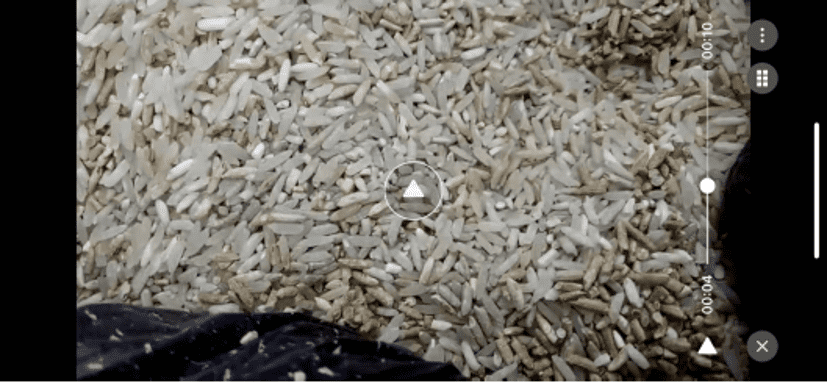
Villager Tan Dabang tested and observed the rice from Cai's family three times. Each time, the rice was relatively yellowish at the beginning, and it started to turn green and smelly after being stored in a fully enclosed store for about 20 days. The villagers speculated that the greenness of the rice was probably related to the pollution of the soil by poisonous copper mud.
As early as the end of 2012, Cai Mengliang found that copper mud was piled up no more than two miles away from his home. He said: "The amount is more than 10,000 tons. They are all piled up in the open air without any treatment. A strong stench can be smelled inside, and after smelling it, it makes people feel very uncomfortable, dizzy and full of heart."
After the poisonous copper mud appeared, the land around the Hegang Brick Factory was difficult to support crops. Tan Dabang said that there were several bosses who had contracted farmland around the brick factory, some planted honeysuckle, some bananas, and some landscape trees, but without exception, they couldn't support them, and eventually they all went bankrupt and left.
There are 28 natural villages in Hegang Village, with more than 4,000 people living in total. The crops grown here are mainly rice, peanuts, green vegetables and soybeans. Several villagers reported to the author that after the poisonous copper mud appeared, the land cultivation conditions were extremely poor. But they all don't know much about the pollution of the land.
After eating contaminated water and grass, cows rot their stomachs and die
Contaminated with the soil, as well as groundwater. Tan Dabang said that the villagers used to drink well water on a daily basis, but now no one dares to drink it anymore.
Near Cai Mengliang's house, in a well 500-600 meters away from the Lihegang poisonous mud site, the author filled a bucket of well water. It smelled a strong odor, and the color was obviously yellow. The well water has been polluted. At present, all villagers in Hegang drink tap water. Most of the tap water was installed after villagers reported the poisonous copper mud incident, and the villagers worried that the tap water might also be polluted.
Five kilometers upstream from the waterworks and the water inlet is the pyrite lake. The hundreds of meters deep waste mine lake is filled with hazardous waste and poisonous copper mud, and waste water often flows into the nearby Moyang River, and the downstream of the river is the Yangchun City Waterworks. Although it is difficult to tell the difference between the water with the naked eye, Tan Dabang believes that the taste of tap water is abnormal and "has a faint smell of potion".
When it comes to water pollution in Yangchun, the Moyang River running through Yangchun City bears the brunt. With the rapid advancement of urbanization, the population of Yangjiang in Guangdong has grown rapidly and the pace of industrial development has accelerated. As early as 2009, the pollution problem in the Moyang River was quite prominent. The pollution of the Moyang River has threatened the water supply security of Yangjiang. In order to ensure safe water supply, the water intake of the water plant is constantly moving upstream.
Villager Yang Hongxu said that the Environmental Protection Bureau of Yangjiang City went to Yangchun to investigate the cause of excessive heavy metals in the water source of the Moyangjiang section of the Yangjiang River, and to investigate the source of the copper mud wastewater that was stolen from the detoxification of the water source in the Yangchun section. Later, people in Yangjiang knew that the water source was polluted, so they set up a project to transfer water from Dahe Reservoir to Jiangcheng District.
The source of this hard pursuit probably points to the pyrite lake above the Moyang River.
Pyrite is another copper mudfill site in Yangchun, where villagers believe that the copper mud is more toxic. Tan Dabang went to observe on February 1 this year, and began to experience chest tightness, shortness of breath, dizziness, and rapid heartbeat in more than ten minutes. Tan Dabang said that a leader of the public security brigade of the Yangchun Public Security Bureau had revealed to him that nuclear waste was buried here at the same time, and that a policeman had fainted while enforcing the law here.
This pyrite lake, which is about 200 meters deep and covers an area of about 40 mu, has been filled up. Tan Dabang estimates that there are about 50 million tons of poisonous copper mud buried here. The top of the lake is covered with a layer of hillside soil, and the white and iron-colored ones are produced by the reaction of chemicals and copper mud. "At that time, the 'protective umbrella' asked the relevant departments to let go of it, and asked the copper slime boss to hire a company in Guangxi that specializes in handling hazardous and waste copper slime, and wanted to use chemicals to desalinate it. But it backfired. The more poisonous it is, the bigger it is that even the nearby cows will die if they eat water plants, the leader of the security brigade said.”
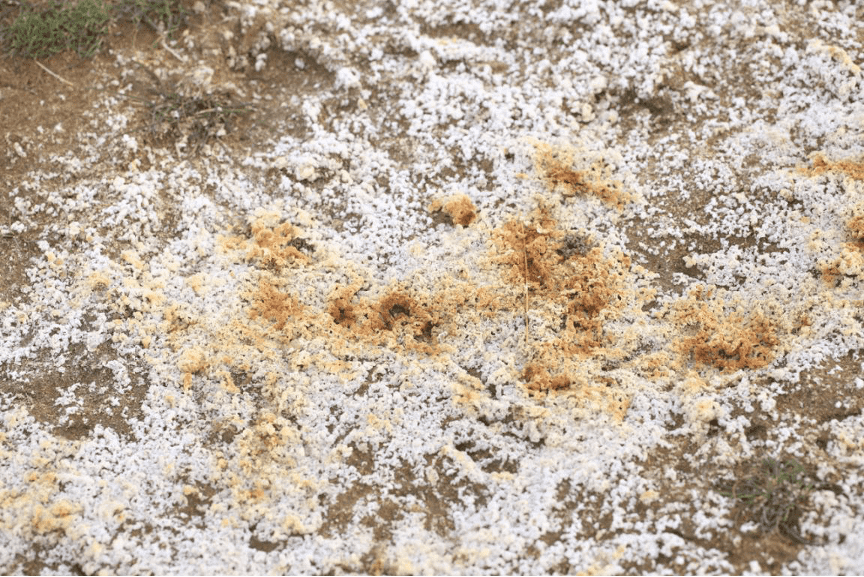
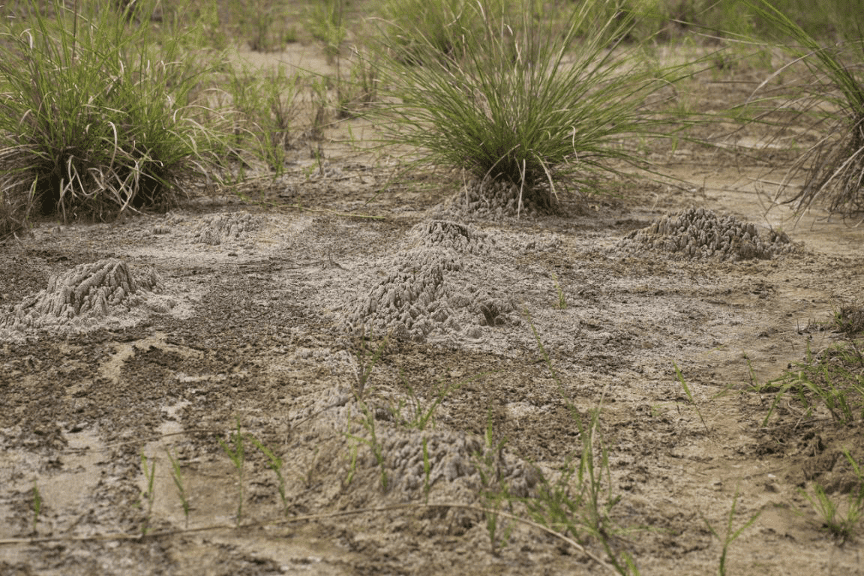
Local villagers corroborated that cattle began to die inexplicably in 2017. Later, experts were sent from the province to dissect the inexplicably dead cow, and they cut open the tripe and found that the tripe and intestines were all rotten. After checking the places where the cattle lived and graze, it was found that the poisonous copper mud of pyrite flowed out with the water, polluting the water and grass, and the cattle died of rotten stomachs.
A villager in his 80s told the author that in 2020, three cows died in his family, all of which died within ten days of buying them. One of the cows was worth 13,000 yuan, and the other was worth 14,000 yuan. They were all cows and could have given birth to cowboys. As far as he knew, the toxic copper mud was dumped in a 200-meter-deep sulfur mine, and the town cadres informed them, "The soil here is poisonous, and we can no longer farm."
At present, this place has been turned into a solar power station. The soil under the solar panel is glowing with white and orange crystals; there is stagnant water under the solar panel. Preliminary measurement by the test paper, PH=2, is strongly acidic water. After sampling and testing, the soil samples of the land exceeded the standard by 2.90 times for lead, 12.00 times for nickel, 27.40 times for copper, 14.30 times for chromium, 4.48 times for zinc, and 3.33 times for arsenic.
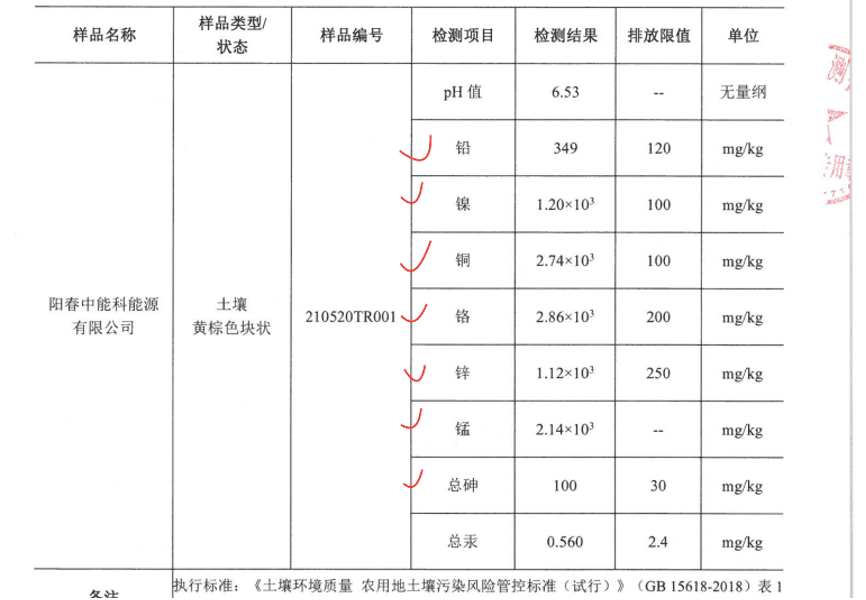
Strange fish with colorful fluorescence
Contaminated groundwater flows into the fish ponds, and strange things start to happen in the fish ponds.
There are many fish ponds around Hegang Village, but in recent years, villagers have complained that it is difficult to feed the fish, and the fish that have been raised even have colored fluorescence when they are cut open.
On the day of the author's visit, nearby villagers brought three big fish to Chen Haijuan's family living in Hegang. Chen Haijuan cut one of the fish open, and found that some parts of the fish were shiny metallic, and some were pale green. The villagers revealed that there are even more strange things here. The fish raised in their fish ponds have crooked mouths and deformed bodies, not the normal shape of running water.


Chen Minqing is a native of Huangsha Village. He usually relies on fish and pig farming to make a living at home. The fish in his family also have fluorescence when they are cut. Chen Minqing said: "I still raise fish now, but they don't dare to eat it. Whoever wants it will eat it."
Chen Minqing remembered a day in March 2019, and his heart lingered with lingering fears. When he was talking that day, suddenly one of his hands and feet could not move. This state lasted for about ten minutes. Later, it was checked that the cerebral blood vessels were blocked, and he began to take medicine. He suspected that it was caused by the poisonous copper mud piled up at the Hegang Brick Factory. Since then, he has switched to drinking tap water and stopped eating fish raised in his own fish pond.
Another villager, who did not want to be named, told the author that he kept four major fish in his own fish pond. At that time, because the water from the ditch on one side was clean and clear, it was introduced into the fish pond. As a result, all the fish in the fish pond were wiped out.
Difficulty in water use greatly restricts the development of local agriculture and fisheries. Although there is a Dahe Reservoir in the local area, it is illegally intercepted by the reservoir and has no ecological flow. As a result, irrigation and fish farming can only rely on sky water and well water. Most fish farmers can only rely on pumping well water. The well water is polluted, the fish pond is polluted, and the villagers are helpless.
This is the state of most villagers. Most of them know the dangers of poisonous copper mud and that the soil and water are polluted, but there is no other way. If they want to feed themselves, they need to continue to grow rice, raise cattle, raise pigs, and raise fish, and they can only continue to suffer from pollution.
Villagers suffered strokes, lost the ability to work, and even died
Tan Dabang noticed that since 2017, more and more people in Hegang Village have fallen ill for no reason. Intestinal gastric cancer, cardiovascular and cerebrovascular diseases also showed a younger trend. In 2020, two people in Hegang Village died of liver cancer and stomach cancer, both in their 40s and 50s.
Yang Hongxu, who lives in Shahe Village, also said that in the past few years, 3 young people in Shahe Village have died of cancer; the elderly suffer from cardiovascular disease, and 7 or 8 people have died. He suspected that the excessive heavy metal nickel in the poisonous mud entered the groundwater and soil, polluting the food and water sources, and then causing damage to the cardiovascular and cerebrovascular of the human body.
"There are more people with hemiplegia due to stroke. The most serious family is three members, the parents and the son. The son is about 30 years old, and the three have lost their labor force." There were 59 stroke patients.
Jiang Sijuan, 70, has three people in her family who had a stroke. After she was diagnosed with a stroke in 2018, Jiang Sijuan had difficulty moving and was unable to do heavier farm work. Her 72-year-old wife Liu Chuanwei also suffered a stroke. Their 42-year-old son was also diagnosed with a stroke in 2018. In the past, he could earn about 150 yuan a day by helping others as part-time workers, but now he can only rely on the subsistence allowance and his wife. His wife is now working outside, earning more than 80 yuan a day, and raising her two children, who are in elementary school and the third year of junior high.

There are also villagers who have completely given up farming. Party member Cai Yelai and his wife, who have the honor of "House of Glory", have lived in the village for a lifetime. Because of the stroke, Cai Yelai has no strength in his hands, and his head often feels uncomfortable, so he can no longer grow vegetables. His wife, Liu Changfu, found out that he had suffered a stroke for three years. He had no money to see a doctor, so he could only ask a barefoot doctor to prescribe medicine for treatment. He has been unable to speak since March last year.

Cai Mengliang and his family have also experienced frequent physical problems in recent years. In 2017, Cai Mengliang's mother suffered from intestinal ulcers that were "inflamed to the point of rotting". In recent years, Cai Mengliang has suffered from angina pectoris from time to time. In 2020, he went to the hospital for examination and found a shadow in his heart and was diagnosed with aortic sclerosis. "All these diseases may be related to the long-term consumption of contaminated rice and well water."
All clues point to poisonous copper slime.
In April 2018, after being reported by villagers, some of the poisonous mud was pulled away. From 2014 to 2018, the villagers of Po Kong suffered from it. The poisonous mud had a strong and irritating smell, and before it was pulled away, the whole village was infected with sore throat.
Can you stop eating these poisonous foods? The villagers complained, "(Even if there is a problem with the land), even if there is a problem with the things, you have to eat it. If you don't grow it yourself, what will you eat? We don't have the conditions to buy everything."
The long-awaited pollution control
Most of the 15 copper mud stacking sites visited by the author this time are outside the scope of the official notification. The pollution in these places is quieter and less known.
"Location 12" There is a small creek beside Reed Lake, and the soil around the creek seeps oily liquid and flows into the creek. The Reed Lake is about 1.6 kilometers away from the Moyang River. Confirmed by aerial photography, the stream eventually flows to the Moyang River.
In Hezai, Shahe Village, the author met two women in their 50s, one was spraying herbicides and the other was working on loose fields. The place where they farm is on the poisonous soil. A villager said that dozens of people in uniform came to take soil tests before, and it took several days.
The former Hongxiang Waste Slag Processing Plant, Hegang Brick Factory and Shahe Village collective fish pond were identified by the scientific research institute under the Ministry of Environmental Protection as a place for "piling up hazardous waste with leaching toxicity and dangerous characteristics", even though they were criticized by the government in a circular , and did not see any governance actions (except for a little governance in Huangshagang in Hegang Village).
Tan Dabang recalled that ten years ago, there were many small fish and clams in the clear canals and small rivers in Hexi Village. After about 2010, the small fish disappeared, and the small insects in the woods could not hear the sound. I asked the people selling clams on the street, and they said that the clams near Yangchun were basically extinct.
Here, there are fewer and fewer healthy organisms, more and more patients, and weaker signatures of life.
Those who should be responsible for this, some have had lawsuits, and more have gone missing.
The tumor under the solar panel turned into a stench that suddenly wafted from the wind, dipped in rainwater and turned into a slow-flowing viscous stream, infiltrating the soil and flowing into the cultivated land of ordinary people, growing into fresh vegetables, bright orange. The pyrite lake scattered with crystals is silently accusing it all.
Pollution continues.

8+1: Heavy Metal Country Tour 2021
In response to severe heavy metal pollution, we want to do something.
Heavy metal pollution is nothing short of a nightmare. Over the years, incidents of children's blood lead, poisoned rice, and incidents in cancer villages across the country have frequently occurred, bringing misery to the countryside. At the same time, heavy metal pollution mostly occurs in villages where there is no right to speak, and it is highly concealed. Under today's national policy of "lucid waters and lush mountains are invaluable assets", environmental pollution is still a very sensitive topic in many areas. Information is covered up, the facts of pollution cannot be made public, and the public's right to know is not fully guaranteed.
In the spring and summer of 2021, we have completed the investigation of 8 villages polluted by heavy metals in 7 provinces in China (there is also 1 extra project: ZiBo hot pot fish ), which is 8+1. Afterwards, we invited a number of friends to write lyrics based on the research data, and invited two heavy metal bands to tour 8 villages, so that heavy metal could pay attention to heavy metal, let more people see the hidden cruelty, and connect more people to participate—— This project is called "Heavy Metal Rural Tour 2021". We look forward to promoting relevant departments and enterprises to remediate and repair 9 places polluted by heavy metals through direct actions, and expect the whole society to pay attention to the problem of heavy metal pollution that is more serious than smog.
related articles:
"Summer of Heavy Metal Bands: Finding 1,000 Popular Judges"
The Winter of Heavy Metal Bands: Finding 8 Metal Bands With Kindness
Raise 50,000 inspection fees
(We borrowed 50,000 for the research and testing costs in 8 places)
At present, under the circumstance that funds and participants are very embarrassed, we have carried out a series of work (research for 4 months and tours in 4 places in the north). Our heavy metal country tour is based on basic fieldwork and detailed testing of local contamination samples. The research locations and tour locations involve northwest, southwest, central, eastern, and southern China.
In order to raise the cost of the tour for the next four stops in the south and the 50,000 inspection fee borrowed from the research in 8 places, our executive team tried to sell the same T-shirts that we used for our tour.
If you would like to donate directly to support us
Please participate in the "Public Activist Excellence Program"
Please scan the following pictures with WeChat
You will see the "Tencent Public Welfare" applet, click to donate to support us~
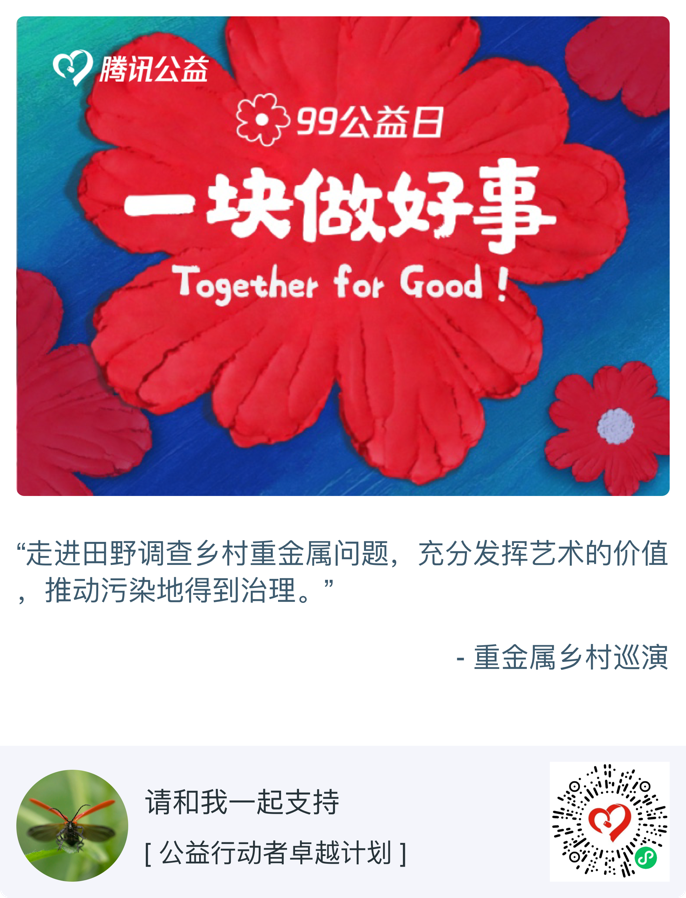
Heavy Metal Country Tour 2021
joint working group
Research team: Xigua, Pingxi, Xiaohuang, Fan Bo, Tian Xi, Nuts
Band: Old Man Music, Soil Improvement
Lyricists: Bing Huang, Uncle Keating, Chang Le, Wolf, Zhou Yan, Li Jia, Dong Qi, Hong Bin, Nuts
Public judges: 80 people
Editing Team: Lazy Man, Duck Duck, Ma Ma Lei, Kate
Executive Team: Wu Laobai, Bing Huang, Chang Le, Cola S, Xiao Ming, Nuts, Hong Bin
Technical support: Huda Soil Resources Protection and Pollution Detection Research Center, Hangzhou Luheng Biology
Design Support & Material Sponsor: Lan Xiaojie
Recording: Zhongyun
Shooting: Lao Bai, Chang Le, Cola S, Hong Bin, Nuts, Che Che, Xiao Zhu, Da Peng
Editing: Laobai, Cheche
Director: Che Che, Da Peng
Public Welfare Support: China Green Development Association
Initiating Organization: Qingpu Public Welfare, Stealth Art
Curator: Zheng Hongbin
Initiator: Nut Brothers

Like my work?
Don't forget to support or like, so I know you are with me..
Comment…